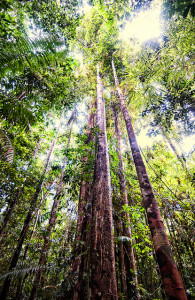Comparative genomics highlight genes that may determine fungal lifestyles.
The Science
Researchers sequenced a fungal endophyte of rubber trees and compared its genome to 36 other fungi, focusing on genes that are crucial to host-fungus interactions.

For this study, researchers sequenced the genome of Xylona heveae, a fungal endophyte from a Peruvian rubber tree, and compared it to 36 other fungal genomes. (Image by Marco Simola for the Center for International Forestry Research (CIFOR), CC BY-NC 2.0)
The Impact
Endophytes reside within living plant cells and can play roles not just in plant health but also within carbon and nitrogen cycles. Understanding the evolution of the endophytic lifestyle could help researchers understand how plants and fungi developed symbiotic relationships, and how the mutualistic association provides host plants with beneficial traits.
Summary
Endophytes are organisms that very commonly reside within living plant cells without harming their hosts and often, in fact, contribute significantly to their survival and physiology. The evolution of endophytism and mechanisms by which they interact with their hosts are still poorly understood. To gain insights into these questions, a team including researchers at the U.S. Department of Energy Joint Genome Institute (DOE JGI), a DOE Office of Science User Facility and longtime collaborators at Clark University, sequenced the genome of Xylona heveae, an endophyte from a Peruvian rubber tree, and then compared its genome to the genomes of 36 related fungi within the phylum Ascomycota. Based on this dataset of 37 fungal genomes, a third of which were sequenced and annotated at the DOE JGI, the team found that endophytes such as X. heveae, in order to avoid triggering their plant hosts’ immune systems, adapted by reducing their CAZymes, cellulose-degrading genes that encode carbohydrate-active enzymes. At the same time, the fungal endophyte also appears to have expanded the number of enzymes that could boost its chances of survival within the host plant’s intercellular spaces. The authors theorized that in adapting to its host, X. heveae has reduced its wood-degrading capabilities to the point that it likely cannot switch to a different lifestyle nor become pathogenic. They also suggested that this fungal endophyte could be transmitted through insects. The report was published in the January 2016 issue of Fungal Biology.
Contacts
Daniel Drell, Ph.D.
Program Manager
Biological Systems Sciences Division
Office of Biological and Environmental Research
Office of Science
US Department of Energy
[email protected]
Igor Grigoriev
Fungal Genomics Program Head
DOE Joint Genome Institute
[email protected]
Funding
- DOE Office of Science
- National Science Foundation
Publications
- Gazis R et al. The genome of Xylona heveae provides a window into fungal endophytism. Fungal Biol. 120(1):26-42, (2016). doi: 10.1016/j.funbio.2015.10.002.